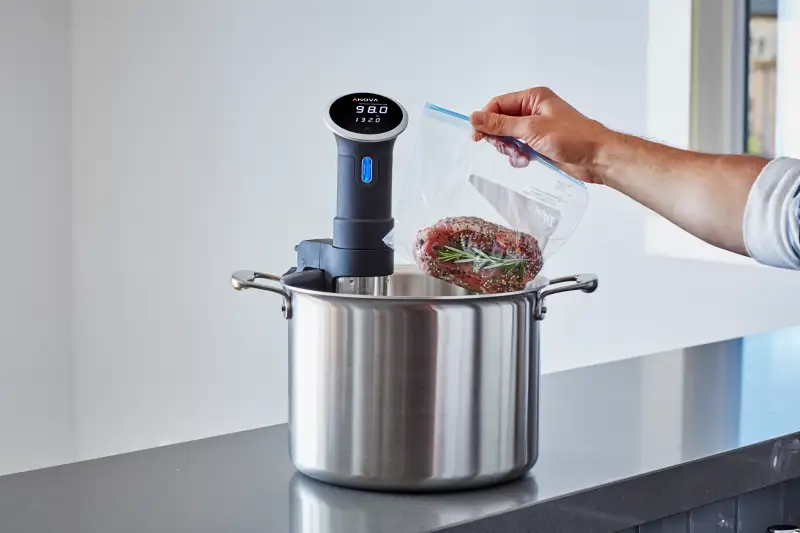These Sous Vide Cooking Devices Will Have You Cooking Like a Pro in No Time

For the last few years, foodies have been buzzing about sous vide, a cooking technique that only sounds complicated and is used by pretty much every big restaurant in the business.
Sous vide (pronounced sue-veed) literally translates to “under vacuum” in French. Food is sealed in a plastic bag and cooked at a precise temperature in a water bath. By regulating the temperature more carefully than a grill, stovetop, or oven, the food produced via sous vide come out more consistently done, without overcooking. (Don't worry: Even the lower temperatures used with sous vide are hot enough to kill pathogens, so it's safe.)
Chefs and home cooks alike especially love sous vide cooking for proteins like steak, fish, and eggs: The slow, gentle cooking results in pieces that are cooked evenly throughout, rather than overdone on the outside and underdone in the middle. The moist cooking method also prevents meats from shrinking, losing volume, and drying out.
Not convinced yet? Sous vide devices can also save you money by making it easier to cook cheaper, tougher cuts of meat and render them tender, without having to babysit the stove or oven (and keep it burning) for hours. If you like, after the food is cooked thoroughly using sous vide, you can pop it onto the grill or inside the broiler briefly to polish it off to your preferred taste and appearance.
Pro chefs use big countertop contraptions for sous vide cooking. But now small, cheaper immersion circulators make sous vide cooking accessible to anybody.
This 900-watt model by Anova Culinary ($200) is the top-selling immersion circulator on Amazon, and it’s been nominated a top pick by reviewers at TheSweethome.com and Epicurious.com.
It might not look like there’s all that much to the device. The gadget resembles an immersion blender, but with a heating element instead of blades on the bottom, and with a digital display at the top.
Part of the reason the device itself is so simple is that it has a Wi-Fi connection, so you can use your phone to program and set it. It is possible to set manually too, if you'd rather. (There’s also a Bluetooth version that’s $65 cheaper, but your phone has to be in range of the gadget to set it.)
Another highly-ranked immersion circulator for sous vide cooking is the ChefSteps Joule model ($180). It’s powerful while being a bit smaller than the Anova. The only hiccup might be that it has no manual controls, so you’re dependent on the app for operating it. That could be a serious drawback if you’re not the type of person permanently glued to your phone (or who doesn’t want to pull it out in the kitchen).
To seal your food for sous vide preparation, you can use a vacuum sealer if you have one. No worries if you don't have one: Plenty of home cooks just get by with carefully sealed zip-top bags that have had all the air pressed out.
We know — cooking dinner in a plastic bag might not sound like the most appetizing thing, but consider one more point in sous vide's favor: It's August, so wouldn't it be nice to have a way to cook that doesn't involve having to turn the oven on or fire up your stovetop and heat up your already-sweltering house even more? We thought so.
We’ve included affiliate links into this article. Click here to learn what those are.
